Cerna® Microscope with Six-Position Epi-Illuminator Module
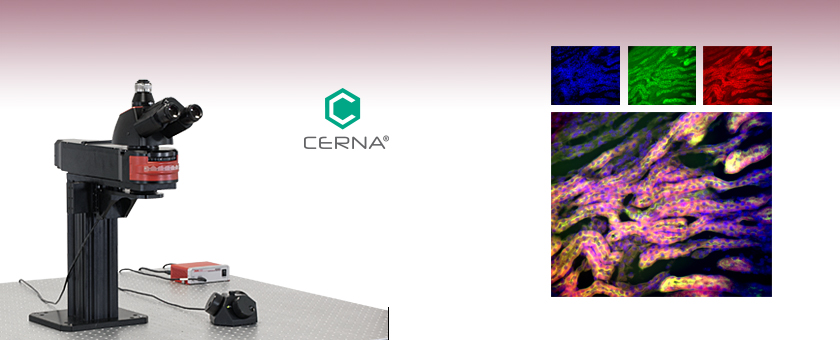
- Equipped with Six-Position Epi-Illuminator Module
- Ready to Accept Objectives, Cameras, Filters, and
Illumination Sources
Cerna™ Microscope Kit 2
(Optical Table Not Included)
Cerna® Microscope Kit 2
(Optical Table Not Included)
Image of a mouse kidney acquired using a Cerna Microscope with the Chrolis™ LED Source and CS505MU Camera. (Courtesy of the Lab of Dr. Peter Stys, University of Calgary.)
Nuclei:
DAPI
(365 nm)
WGA (Wheat
Germ Agglutinin):
AF 488 (475 nm)
Phalloidin:
AF 568
(565 nm)

Please Wait
Features
- Six-Position Epi-Illuminator Module Accepts Solis® High-Powered LEDs, Chrolis™ High-Powered LED Sources, or Ø3 mm Liquid Light Guides
- Large and Open Working Space Underneath the Objective Ideal for Sample Apparatuses, Recording Chambers, and Micromanipulators
- Accepts C-Mount Cameras from Thorlabs and Most Major Manufacturers
- Motorized Focus Control of Objective
- Trinoculars with 10X Eyepieces
- Modular Design Allows User to Modify the Microscope's Optical Path
This Cerna® microscope configuration provides an optical path that is ideal for experiments requiring epi-illumination or reflected-light imaging. The epi-illuminator module accepts up to six fluorescent filter sets, ideal for targeting spectrally separated fluorophores, while the microscope body has ample space beneath the objective for adding Thorlabs' sample stages, micromanipulators, and other accessories needed for fluorescence imaging of in vivo or in vitro samples. A motorized objective holder provides 1" of vertical focusing adjustment for the objective.
Trinoculars with a camera port support real-time viewing of the sample directly through the eyepieces. The C-mount-threaded camera port is compatible with most industry-standard cameras, which can be used to view the sample on a computer screen in real time or to capture images.
Unlike competing microscopes with similar capabilities, the Cerna platform's modularity lets the user quickly install and remove the microscope modules as needed for each experiment, providing a high degree of access and control. The open space beneath the objective provides ample room for in vivo imaging. Alternatively, in vitro samples can be studied by positioning sample stages below the objective using fixed arms that can be attached directly to the microscope or rigid stands. A variety of mounting surfaces are offered, allowing custom components to be integrated with your experiment.
To address a wide range of experimental parameters, Thorlabs offers eight Cerna microscope configurations, which are summarized in the table below. In addition, we can work with you to configure a microscope that meets your unique needs. To contact our team, please e-mail ImagingSales@thorlabs.com. We also offer Cerna components individually for custom modifications.
| Cerna Microscopes | Kit 1 | Kit 2 | Kit 3 | Kit 4 | Kit 5 | Kit 6 | Kit 7 | Kit 8 |
|---|---|---|---|---|---|---|---|---|
| Objective Holder | Single | Single | Single | Dual | Dual | Dual | Dual | Dual |
| Epi-Illumination | 1 Cube | Up to 6 Filter Sets | 1 Cube | Up to 6 Filter Sets | Up to 6 Filter Sets | Up to 6 Filter Sets | Up to 6 Filter Sets | Up to 6 Filter Sets |
| Trans-Illumination | - | - | Brightfield (Visible) |
Brightfield (Visible) |
Dodt Contrast and Brightfield (Visible) |
Dodt Contrast and Brightfield (Visible and NIR) |
DIC Imaging and Brightfield (Visible and NIR) |
DIC Imaging and Brightfield (Visible and NIR) |
| XY Motion | - | - | - | - | - | Microscope Translator |
- | Translating Platform |
Cerna® Microscope Kit 2
This Cerna microscope kit was designed from our line of modular components to provide several convenient features for imaging, highlighted below. We also offer a selection of microscope objectives, cameras, and illumination modules that can be used to complement this microscope configuration and customize it to your experiment. Details can be found on the Microscope Add-Ons tab. The Kit Components tab details the components used in this microscope configuration, as well as a link to each component's webpage, where additional information (such as mechanical drawings) is available.
Epi-Illumination
Add-Ons: Epi-Illumination
Features
- Six-Position Epi-Illuminator Module (Filter Sets Sold Separately)
- Compatible Light Sources
- Solis® High-Power LEDs (Requires SM2A56 Adapter)
- Chrolis™ High-Power LED Sources or Other Sources that Use Ø3 mm Liquid Light Guides (Requires LLG3A6 Adapter)
This microscope is able to target multiple fluorophores through the use of a six-position epi-illuminator module that couples light emitted by the illumination source into the imaging path, through the objective, and onto the sample. The epi-fluorescence generated by the sample passes through the module to the eyepieces and camera. A D3T female dovetail on the rear of the microscope accepts a wide range of white-light lamps. The illumination path includes AR-coated conditioning optics, a field stop diaphragm, and a shutter.
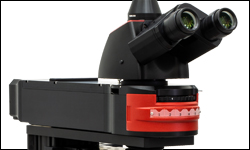
Click to Enlarge
This Cerna® microscope kit features an epi-illuminator module with a 6-position filter turret. The filter position is labeled on the knurled wheel that rotates the turret.

Click to Enlarge
The rotating turret accommodates up to six filter sets (not included).
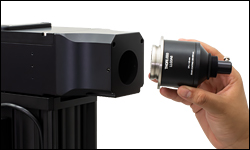
Click to Enlarge
The back of the epi-illuminator module has a female D3T dovetail that can be adapted to accept liquid light guides and LEDs.
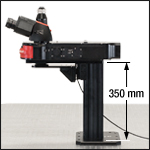
Click to Enlarge
The microscope body is based on a 95 mm optical rail.
Microscope Body
Features
- Large Working Volume: Optical Path is 7.74" (196.6 mm) Away from Edge of Rail
- Linear Dovetail Surface Allows Modules to be Added and Removed
- 350 mm Body Height to Accommodate Sample Stages Mounted on Rigid Stands or Fixed Arms
- Motorized Objective Focusing Module with 1" Travel
- Mechanically Compatible with Thorlabs' 95 mm Rail Platforms
The backbone of this microscope is the 350 mm tall microscope body based on Thorlabs' 95 mm Precision Optical Rails, providing stable long-term support and excellent vibrational damping. Its linear dovetail mounting surface allows modules to be removed when they are not needed, freeing additional workspace and opening the door to user customization. For alternate rail heights, please see the full web presentation.
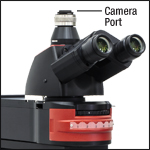
Click to Enlarge
This microscope kit includes trinoculars with a camera port for widefield viewing.
Widefield Viewing
Add-On: Widefield Viewing
Features
- Fixed Magnification Camera Port with C-Mount Accepts Most Industry-Standard Cameras
- Trinoculars with 10X Eyepiece Magnification and Adjustable Interpupil Distance
Widefield viewing is provided by trinoculars and a camera tube. The eyepieces feature an adjustable interpupil distance and rotate individually to allow the focus to be coarsely adjusted for each eye.
The included camera tube contains all of the optics needed to image the light from the objective onto a camera sensor. External C-mount (1.00-32") threads on the top of the camera tube accept Thorlabs' scientific cameras, as well as cameras from most major manufacturers. For additional viewing port and camera tube options, please see the full web presentation.
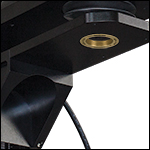
Click to Enlarge
This Cerna microscope kit has a single objective holder (objective not included).
Objective Holder
Add-On: Objectives
Features
- Threaded for M32 x 0.75 Objectives
- Included Adapters:
- M25 x 0.75 Internal Threads
- RMS Internal Threads
The Single-Objective Nosepiece connects to the motorized mounting arm on the microscope body via six M4 counterbores to provide 1" of motorized vertical translation of the objective. The nosepiece features an M32 x 0.75 threaded port for mounting objectives and four 4-40 through taps for 60 mm cage system compatibility. Two objective thread adapters are also included to provide compatibility with other common objective threads: M25 x 0.75 and RMS. To mount multiple objectives, please see the full web presentation for other mounting options. Microscope objectives are available for purchase separately from Thorlabs, and we can also order other objectives from either Nikon or Olympus upon request. Keep in mind that the total system magnification will depend upon the objective chosen; see the Objective, Scan, and Tube Lens Tutorial for details.
This kit configuration is constructed from our modular Cerna® components. See the comprehensive list below for each included item.
| Item # | Description | Photo (Click to Enlarge) |
|---|---|---|
| Microscope Body | ||
| CEA1350 | Cerna Microscope Body with Epi-Illumination Arm, 350 mm Rail Height |  |
| Widefield Viewing | ||
| LAURE1 | Trinoculars with Eyepieces |  |
| TC1X | 1X Camera Tube with C-Mount |  |
| Epi-Illumination | ||
| CSE2100 | Epi-Illuminator Module for Six Filter Sets |  |
| Objective Holder | ||
| CSN100 | Single-Objective Nosepiece |  |
| PLSZ | Motorized Module with 1" Travel, 95 mm Dovetail |  |
| PLSZ1 | Angle Bracket for Edge-Mounted Arms |  |
| MCMK3 | 3-Knob USB HID Joystick |  |
| MCM301 | Three-Channel Controller for Motorized Rigid Stands and PLS Series Stage |  |
| Objective Threading Adapters | ||
| M32M25S | External M32 x 0.75 Threads and Internal M25 x 0.75 Threads |  |
| M32RMSS | External M32 x 0.75 Threads and Internal RMS Threads |  |
Application-Optimized Cerna Microscopes
Developed in collaboration with our colleagues in the field, the Cerna microscopy platform is uniquely modular and flexible, making it adaptable to a wide range of demanding experimental requirements. If you would like to work with our application specialists, engineers, and sales team to design your own microscope, please email ImagingSales@thorlabs.com.
Selected Accessories
In order to image with this microscope, it is necessary to add a scientific camera, an epi-illumination source, filter sets, objectives, and sample holders. It is often possible to improve the quality of your experimental data by carefully selecting accessories that complement your specific experiment. To that end, we have ensured that Cerna® microscopes are compatible with a wide range of accessories. The information below compares the Cerna-compatible components that are manufactured or sold by Thorlabs. We have also indicated when it is possible to use equipment designed by other manufacturers.
Content
- Scientific Cameras for Widefield Viewing
- Illumination Sources for Epi-Illumination
- Filter Sets for Epi-Fluorescence
- Objectives
- Sample Holders
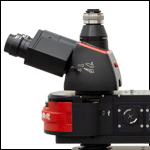
Click to Enlarge
The camera port provides a fixed magnification for light from the sample.
Scientific Cameras for Widefield Viewing
- Visualize the Field of View at a Computer
- Any C-Mount Camera is Compatible with a Cerna Microscope
Thorlabs offers scientific cameras optimized for a range of imaging needs. Cameras allow the field of view to be displayed on a computer screen and saved for later reference. Viewing your sample from a computer also enables remote sample positioning using our motion control accessories (see below), allowing samples to be moved in sensitive setups without introducing additional vibrations from your hands.
This Cerna microscope configuration includes a camera tube, which provides a fixed magnification at the image plane.
Any camera with C-Mount (1.00"-32) threading is compatible with this microscope. We recommend the CS2100M-USB Quantalux® Scientific sCMOS Camera; see the table below for more details. For other options, please see our complete range of scientific cameras.
| CS2100M-USB Specifications | |
|---|---|
| Product Photo (Click to Enlarge) |
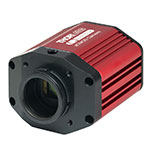 |
| Sensor Type | Monochrome sCMOS |
| Effective Number of Pixels (Horizontal x Vertical) |
1920 x 1080 |
| Imaging Area (Horizontal x Vertical) |
9.6768 mm x 5.4432 mm |
| Pixel Size | 5.04 µm x 5.04 µm |
| Optical Format | 2/3" (11 mm Diagonal) |
| Max Frame Rate | 50 fps (Full Sensor) |
| Sensor Shutter Type | Rolling |
| Peak Quantum Efficiency | 61% at 600 nm |
| PC Interface | USB 3.0 |
| Housing Dimensions | 2.77" x 2.38" x 1.88" (70.4 mm x 60.3 mm x 47.6 mm) |
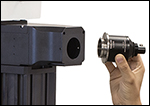
Click to Enlarge
Secure a Liquid Light Guide to the Six-Position Epi-Illuminator Module with a D3T Dovetail-to-LLG Adapter
Illumination Sources for Epi-Illumination
- White Light Sources Illuminate the Field of View Through the Objective
- Available Options Include Solis® LEDs, Chrolis™ LED Sources, or Other Sources Coupled through Ø3 mm Liquid Light Guide
- Light is Tuned by Filter Sets for Specific Fluorophores (See Below)
The six-position epi-illuminator module that is included with this Cerna microscope kit requires a broadband white light source that emits across the visible region of the spectrum. Broadband emission makes it possible for the same microscope to stimulate fluorophores that have absorption wavelengths that are spectrally separated. Several filter sets aimed at common fluorophores are available below.
The Solis LED light sources have multiple wavelength emitting options, including broad sprectrum emission throughout the visible range. These LEDs are designed to be controlled by the DC20 or DC2200 drivers. The Solis LED is outfitted with collimating optics and can be mounted directly to the back of the epi-illuminator module using the SM2A56 dovetail adapter.
The Chrolis LED sources are user-configurable light engines that efficiently combine the output of six LEDs into a single liquid light guide (LLG). They are ideal for fluorescence imaging that requires up to six wavelengths of light. These sources are available in two pre-set configurations, as well as custom configurations; please see the full web presentation for more details. The Chrolis sources are compatible with the epi-illuminator module via our LLG3A6 adapter, which connects and collimates any Ø3 mm LLG to a female D3T dovetail; see image to the upper right.
SOLIS® LED Features
|
Chrolis™ LED Source Features
|
| Filter Transmission Spectraa | ||
|---|---|---|
| Item # | Target Fluorophore | Transmission Graph (Click for Plot) |
| MDF-BFP | BFP (Blue Fluorescent Protein) | |
| MDF-GFP2 | Alexa Fluor® 488 | |
| MDF-MCHAb | mCherry | |
| MDF-MCHCb | mCherry | |
| MDF-TOM | tdTomato | |
| MDF-CY5 | Cy5 | |
| MDF-CY55 | CY5.5 | |
| MDF-CY7 | Cy7 | |
| MDF-NIR | LI-COR IRDye® 800CW | |
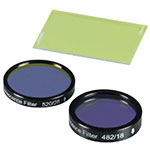
Click to Enlarge
Thorlabs' MDF-GFP2 Filter Set
Filter Sets for Epi-Fluorescence
- Tune Epi-Illumination Source for the Excitation and Detection of Specific Fluorophores
- Up to Six Filter Sets can be Installed Simultaneously
- Thorlabs' Fluorescent Filter Sets Available
- Utilize Fluorescence Filters from Other Major Manufacturers
The epi-illumination module included with this microscope contains a turret that can hold up to six filter sets. The turret can be rotated by hand to switch between the filter sets. To learn more about the features of the CSE2100 Epi-Illuminator Module included with this microscope, please see its full web presentation.
The filter sets we offer, which consist of an excitation filter, an emission filter, and a dichroic mirror, come in the industry-standard sizes. For excitation and emission filters, the standard dimensions are Ø25 mm, and for dichroic mirrors, the standard dimensions are 25 mm x 36 mm. This allows Cerna microscopes to be compatible with filters from all major manufacturers.
Several popular filter sets are listed with their target fluorophores in the table to the right. Please see the full web presentation for the entire line of Thorlabs' filter sets.
Objectives
- Cerna Microscope Kit 2 Directly Accepts Objectives with M32 x 0.75 Threads
- Includes Thread Adapters for Compatibility with Objectives from Major Manufacturers
- M25 x 0.75-Threaded Objectives (Nikon)
- RMS-Threaded Objectives (Olympus)
The nosepiece of this microscope has one M32 x 0.75-threaded bore for mounting objectives. The M32 x 0.75 thread standard offers a larger back aperture than previous standards and is used by newer widefield microscope objectives such as Thorlabs' TL10X-2P and TL15X-2P multiphoton apochromatic microscope objectives. M25 x 0.75- and RMS-threaded adapters are included for compatibility with most objectives from Olympus and Nikon. Shown below are selected widefield Nikon objectives that are commonly used with this microscope kit. They can be mounted in the microscope’s CSN100 Single-Objective Holder using the M32M25S Brass Microscope Adapter (both included in this configuration). We offer other objectives and can order objectives outside our catalog upon request.
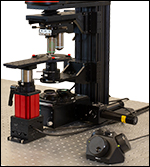
Click to Enlarge
Slide Holder in a Cerna® Microscope
Sample Stages and Holders
- Rigid Stands to Hold Samples Underneath and Around the Objectives
- Designed for Slides, Petri Dishes, Well Plates, Recording Chambers, Micromanipulators, and Custom Inserts
- Translation Stages with 1" of X and Y Travel Available
- Fixed Arms Allow Fast XY Stage, Lens Tubes, and/or Cage Systems to be Placed Directly Into the Optical Path
- CSA1000: For Our MLS203-1 Fast XY Scanning Stage
- CSA1001: For Ø1" Lens Tubes and 30 mm Cage Systems
- CSA1002: For Ø2" Lens Tubes and 60 mm Cage Systems
Thorlabs offers highly configurable solutions for mounting your sample beneath the objective of a Cerna Microscope. Rigid stands are available with multiple platform styles that can accept slides, petri dishes, recording chambers, micromanipulators, and custom inserts. The included collar makes them lockable at a height and angle chosen by the user. We also manufacture translation stages for these rigid stands that provide motorized horizontal translation of the sample.
Our fixed arms enable the sample stage to be attached directly to the microscope body via a dovetail that extends the full height of the microscope body, allowing the arms to be positioned anywhere along the body height. For a pre-configured sample holder solution, use the CSA1000 fixed arm with the MLS203-1 Fast XY Scanning Stage. This stage is compatible with our MZS500-E Piezo-Driven Insert, which adds high-resolution Z-axis adjustments. Alternatively, the CSA1001 and CSA1002 rigid arms are compatible with Thorlabs' wide selection of optomechanical components, allowing custom sample holder configurations and additional optics to be easily integrated with this microscope.
Several common options are outlined below, while our full selection of sample holders can be explored in the Cerna Components presentation.
Rigid Stands
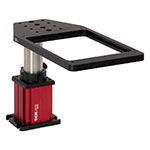 Click to Enlarge MP10M(/M) Rigid Stand with Rectangular Insert Holder
|
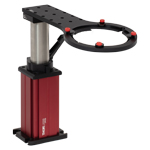 Click to Enlarge MPRC(/M) Recording Chamber Holder, MPP15 Post, and
|
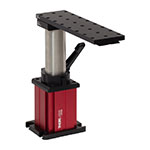 Click to Enlarge MP10(/M) Rigid Stand with Platform
|
Fixed Arms
CSA1000 Fixed Arm
|
CSA1001 Fixed Arm
|
CSA1002 Fixed Arm
|
| Posted Comments: | |
| No Comments Posted |
Click on the different parts of the microscope to explore their functions.
Elements of a Microscope
This overview was developed to provide a general understanding of a Cerna® microscope. Click on the different portions of the microscope graphic to the right or use the links below to learn how a Cerna microscope visualizes a sample.
Terminology
Arm: Holds components in the optical path of the microscope.
Bayonet Mount: A form of mechanical attachment with tabs on the male end that fit into L-shaped slots on the female end.
Bellows: A tube with accordion-shaped rubber sides for a flexible, light-tight extension between the microscope body and the objective.
Breadboard: A flat structure with regularly spaced tapped holes for DIY construction.
Dovetail: A form of mechanical attachment for many microscopy components. A linear dovetail allows flexible positioning along one dimension before being locked down, while a circular dovetail secures the component in one position. See the Microscope Dovetails tab or here for details.
Epi-Illumination: Illumination on the same side of the sample as the viewing apparatus. Epi-fluorescence, reflected light, and confocal microscopy are some examples of imaging modalities that utilize epi-illumination.
Filter Cube: A cube that holds filters and other optical elements at the correct orientations for microscopy. For example, filter cubes are essential for fluorescence microscopy and reflected light microscopy.
Köhler Illumination: A method of illumination that utilizes various optical elements to defocus and flatten the intensity of light across the field of view in the sample plane. A condenser and light collimator are necessary for this technique.
Nosepiece: A type of arm used to hold the microscope objective in the optical path of the microscope.
Optical Path: The path light follows through the microscope.
Rail Height: The height of the support rail of the microscope body.
Throat Depth: The distance from the vertical portion of the optical path to the edge of the support rail of the microscope body. The size of the throat depth, along with the working height, determine the working space available for microscopy.
Trans-Illumination: Illumination on the opposite side of the sample as the viewing apparatus. Brightfield, differential interference contrast (DIC), Dodt gradient contrast, and darkfield microscopy are some examples of imaging modalities that utilize trans-illumination.
Working Height: The height of the support rail of the microscope body plus the height of the base. The size of the working height, along with the throat depth, determine the working space available for microscopy.
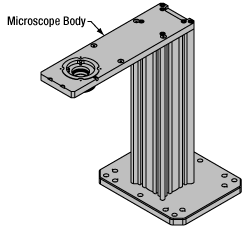 Click to Enlarge
Click to EnlargeCerna Microscope Body
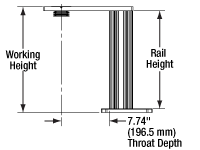
Click to Enlarge
Body Details
Microscope Body
The microscope body provides the foundation of any Cerna microscope. The support rail utilizes 95 mm rails machined to a high angular tolerance to ensure an aligned optical path and perpendicularity with the optical table. The support rail height chosen (350 - 600 mm) determines the vertical range available for experiments and microscopy components. The 7.74" throat depth, or distance from the optical path to the support rail, provides a large working space for experiments. Components attach to the body by way of either a linear dovetail on the support rail, or a circular dovetail on the epi-illumination arm (on certain models). Please see the Microscope Dovetails tab or here for further details.
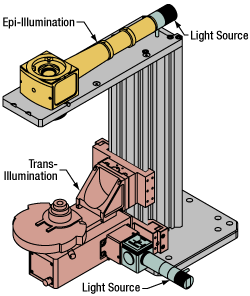 Click to Enlarge
Click to EnlargeIllumination with a Cerna microscope can come from above (yellow) or below (orange). Illumination sources (green) attach to either.
Illumination
Using the Cerna microscope body, a sample can be illuminated in two directions: from above (epi-illumination, see yellow components to the right) or from below (trans-illumination, see orange components to the right).
Epi-illumination illuminates on the same side of the sample as the viewing apparatus; therefore, the light from the illumination source (green) and the light from the sample plane share a portion of the optical path. It is used in fluorescence, confocal, and reflected light microscopy. Epi-illumination modules, which direct and condition light along the optical path, are attached to the epi-illumination arm of the microscope body via a circular D1N dovetail (see the Microscope Dovetails tab or here for details). Multiple epi-illumination modules are available, as well as breadboard tops, which have regularly spaced tapped holes for custom designs.
Trans-illumination illuminates from the opposite side of the sample as the viewing apparatus. Example imaging modalities include brightfield, differential interference contrast (DIC), Dodt gradient contrast, oblique, and darkfield microscopy. Trans-illumination modules, which condition light (on certain models) and direct it along the optical path, are attached to the support rail of the microscope body via a linear dovetail (see Microscope Dovetails tab or here). Please note that certain imaging modalities will require additional optics to alter the properties of the beam; these optics may be easily incorporated in the optical path via lens tubes and cage systems. In addition, Thorlabs offers condensers, which reshape input collimated light to help create optimal Köhler illumination. These attach to a mounting arm, which holds the condenser at the throat depth, or the distance from the optical path to the support rail. The arm attaches to a focusing module, used for aligning the condenser with respect to the sample and trans-illumination module.
 |
 |
 |
 |
 |
 |
 |
 |
| Epi-Illumination Modules | Breadboards & Body Attachments |
Brightfield | DIC | Dodt | Condensers | Condenser Mounting | Light Sources |
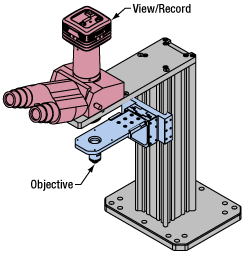 Click to Enlarge
Click to EnlargeLight from the sample plane is collected through an objective (blue) and viewed using trinocs or other optical ports (pink).
Sample Viewing/Recording
Once illuminated, examining a sample with a microscope requires both focusing on the sample plane (see blue components to the right) and visualizing the resulting image (see pink components).
A microscope objective collects and magnifies light from the sample plane for imaging. On the Cerna microscope, the objective is threaded onto a nosepiece, which holds the objective at the throat depth, or the distance from the optical path to the support rail of the microscope body. This nosepiece is secured to a motorized focusing module, used for focusing the objective as well as for moving it out of the way for sample handling. To ensure a light-tight path from the objective, the microscope body comes with a bellows (not pictured).
Various modules are available for sample viewing and data collection. Trinoculars have three points of vision to view the sample directly as well as with a camera. Double camera ports redirect or split the optical path among two viewing channels. Camera tubes increase or decrease the image magnification. For data collection, Thorlabs offers both cameras and photomultiplier tubes (PMTs), the latter being necessary to detect fluorescence signals for confocal microscopy. Breadboard tops provide functionality for custom-designed data collection setups. Modules are attached to the microscope body via a circular dovetail (see the Microscope Dovetails tab or here for details).
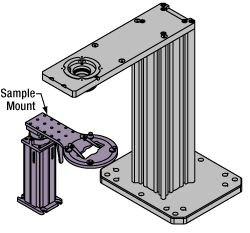 Click to Enlarge
Click to EnlargeThe rigid stand (purple) pictured is one of various sample mounting options available.
Sample/Experiment Mounting
Various sample and equipment mounting options are available to take advantage of the large working space of this microscope system. Large samples and ancillary equipment can be mounted via mounting platforms, which fit around the microscope body and utilize a breadboard design with regularly spaced tapped through holes. Small samples can be mounted on rigid stands (for example, see the purple component to the right), which have holders for different methods of sample preparation and data collection, such as slides, well plates, and petri dishes. For more traditional sample mounting, slides can also be mounted directly onto the microscope body via a manual XY stage. The rigid stands can translate by way of motorized stages (sold separately), while the mounting platforms contain built-in mechanics for motorized or manual translation. Rigid stands can also be mounted on top of the mounting platforms for independent and synchronized movement of multiple instruments, if you are interested in performing experiments simultaneously during microscopy.

This microscope configuration can be tailored to your particular imaging needs through the use of our kit functionality. Its components can be added all at once to the shopping cart using the "Add Kit" button at the bottom of the ordering area, or individually using the shopping cart icon next to each item. Items may be removed from the default item list by changing the value in the "Qty" box to 0 before clicking the "Add Kit" button. Once added, peruse our catalog of modular microscope components to further customize the microscope kit in your cart. A discount is offered when a sufficient number of components are purchased. Please see the Kit Components tab for additional information about each component in this microscope kit.
 Products Home
Products Home














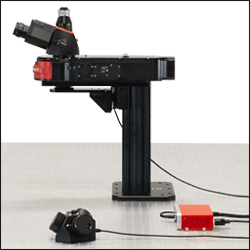
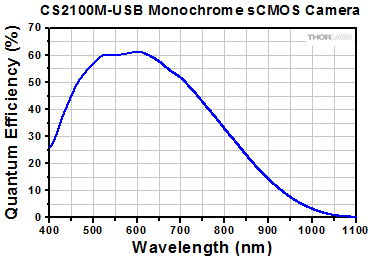
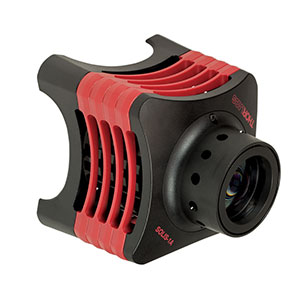
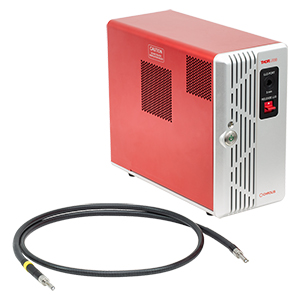







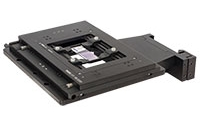
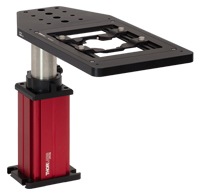
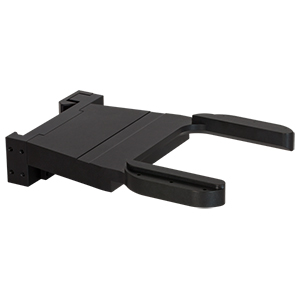
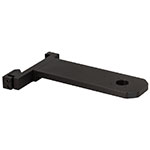
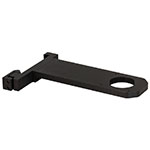
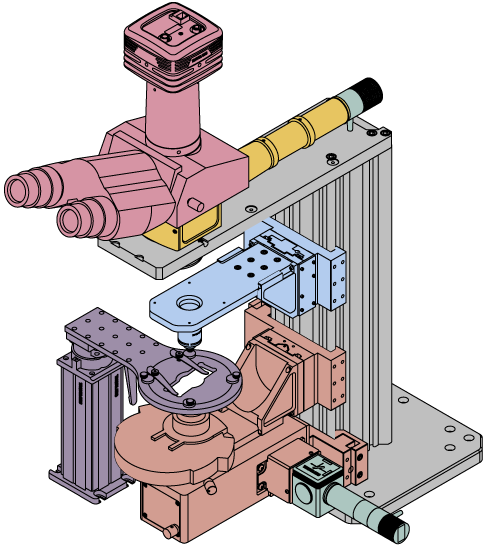























 Kit 2: Six-Position Epi Turret
Kit 2: Six-Position Epi Turret